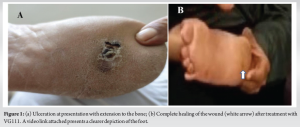The novel formulation, VG111, has shown potential as an effective treatment of non-healing chronic wounds, as evidenced in this case report.
Dr. Gaurav Bhardwaj, Department of Orthopedic, PSRI Multispeciality Hospital, Saket, New Delhi, India. E-mail: drgboffice@gmail.com
Introduction: Chronic wounds pose a significant burden on patients’ physical and mental well-being and significantly raise health-care costs.
Case report: We report healing with VG111 application alone in a case of chronic wound in a patient who sustained a shell injury to the heel 35 years prior in 1988. Despite conventional wound care and multiple surgeries, the wound persisted. Application of VG111 resulted in complete healing of the wound within 3 months and restored the patient’s ability to walk normally as shown by repeat X-ray post 2 years of healing.
Conclusion: The management of non-healing chronic wounds pose major challenges in clinical practice. This novel formulation may offer a potential solution for patients with chronic wounds.
Keywords: Chronic wound, wound healing, natural product, sinus, calcaneal osteomyelitis.
Wound healing is a complex process and consists of overlapping phases of hemostasis, inflammation, proliferation, and remodeling [1]. A chronic wound is a wound that does not progress through a normal, and timely repair, and the healing process is unable to restore the wound’s anatomical and functional integrity within a period of 3 months [2]. These wounds are susceptible to retraumatization and may progress in size. Chronic wounds place a substantial burden on health-care systems and can lead to prolonged patient suffering and high financial expenditures. The prevalence of chronic wounds is estimated to be 1.51–2.21/1000 population globally [3]. As the world’s population ages, the incidence is predicted to increase. More than 50% of chronic wounds involve the foot region and consist of diabetic foot ulcers (DFUs), pressure injuries or ulcers, and arterial and venous ulcers [4]. Traumatic injuries, such as shell injuries, may result in chronic wounds, and the high kinetic velocity of these projectiles is frequently linked to unfavorable clinical and functional outcomes, posing therapeutic challenges [5]. Pressure injury (PI) is an area of localized tissue injury as a result of prolonged pressure, shearing, or friction and usually occurs over bony prominence [6]. The National PI Advisory Panel has classified PI into four stages; stage IV involves full tissue loss with exposure of muscle or bone. Approximately one-third of all stage IV pressure ulcers may progress to osteomyelitis further complicating treatment [6, 7]. At present, the treatment regimen for chronic wounds consists of debridement, negative pressure wound therapies, hydrogels, hydrocolloids, and foam dressings, among other therapeutic approaches [1]. The necessity for alternative therapies to address health issues such as non-healing chronic wounds has prompted a renewal of interest in natural medications. The World Health Organization has reported a rising global trend in the use of herbal medicines and phytonutrients to address a range of health issues across diverse national health-care systems [8]. It is estimated that 80% of the world’s population are treated by traditional medicines to meet their primary health-care needs [9]. Numerous medicinal plants show potential for synergy with traditional antimicrobial agents to target bacterial virulence factors [10] and have demonstrated effectiveness in wound care management [11]. VG111 is a novel natural product formulation patented under no. 353978. (Application no. 201611030748, https://iprsearch.ipindia.gov.in/publicsearch). Further details regarding the product can be accessed at ipindiaservices.gov.in/publicsearch. The formulation comprises natural ingredients, with all herbs described in the Ayurvedic Pharmacopeia of India. Approval for VG111’s use in wound care was granted by the state drug licensing authority Ayurveda, Yoga and Naturopathy, Unani, Siddha, and Homeopathy of India in 2020. Recent research involving both canine and human patients has shown VG111 to exhibit exceptional wound-healing properties and accelerate the recovery process [12]. We present a case report of a patient with chronic sinus and discharge for 35 years due to a long-standing shell injury on his right heel. Subsequently, the patient developed calcaneal osteomyelitis (CO). Standard wound care approaches failed to promote healing. However, the use of VG111 resulted in remarkable wound healing within 3 months of its use. This case highlights the effectiveness of VG111, a novel wound care formulation in the treatment of chronic wounds.
A 55-year-old male patient presented to the outpatient department of orthopedics with a history of shell injury to his right heel sustained 35 years prior (1988). The injury resulted in the formation of sinus and discharge, which persisted despite numerous attempts of conventional wound care and surgery. He had previously undergone three surgeries for debridement and bone curettage at other facilities for the same but with no relief and the discharge continued to ooze out. The patient reported significant discomfort due to the chronic wound as he was unable to walk properly and relied on the aid of crutches for over three decades. On examination, the wound appeared as a non-healing sinus with discharge on the central plantar aspect of the calcaneus (Fig. 1a). A swab was collected from the wound site and sent for culture on August 7th, 2020, and it yielded growth of Escherichia coli. Magnetic resonance imaging (MRI) of the affected ankle on December 19th, 2022, also indicated that the patient had osteomyelitis of the right calcaneus. It was reported as a focal area (13.8 mm [AP] × 11.2 mm [CC] × 24 mm [TR]) of signal alteration appearing slightly hyperintense in T2-weighted short-tau inversion recovery images, seen in the heel region just below the plantar fascia. Mild surrounding fat stranding was observed, along with an overlying subcutaneous defect. There was no obvious collection or involvement of the calcaneum.
Since the conventional wound care approaches were ineffective, VG111 was applied topically on the affected wound on a daily basis. No additional treatments were used during this period. Remarkably, wound healing significantly improved after initiating treatment with VG111. The sinus and discharge stopped with surrounding tissue showing signs of healthy granulation tissue. Within 3 months of treatment with VG111 alone, there was complete healing of the wound with no further surgical intervention needed. (Fig. 1b). Follow-up X-ray of the right ankle (Fig. 2) confirmed the absence of soft-tissue changes, signifying the successful resolution of the chronic wound. The patient was able to resume his daily activities after reporting significant improvement in his mobility.
Management of chronic wounds is challenging and necessitates a systemic, interdisciplinary approach to the patient, any comorbid conditions they may have, and the wound itself. We present a case report of a 55-year-old male patient with a shell injury to his heel who developed a chronic non-healing wound with the development of CO. Osteomyelitis of the calcaneus presents a significant challenge for treatment, accounting for 7–8% of all osteomyelitis in adults [13] and may set in after trauma or as a complication of diabetic foot. Delayed healing or post-operative infections can occur in up to 25% of cases [14] and the rate of major amputations has been reported 15 times more in cases of CO [15]. Treatment options are varied and include surgical excision, parenteral antibiotics, and in some cases, amputation of the lower extremity. Furthermore, there is a paucity of information comparing the success rate of surgical debridement of necrotic bone with antimicrobial therapy. Despite the lack of research to establish precise treatment duration or definitions of “cure” from infection, antibiotic therapy is frequently employed in the treatment of persistent osteomyelitis [16]. In addition, while antimicrobial wound dressings are commonly used to reduce the risk of wound contamination, their effectiveness in promoting wound healing is uncertain due to potential cellular toxicity [17]. The clinical use of VG111, both in humans and animals, has affirmed its ability to promote cellular proliferation without inducing cytotoxicity, even with long-term use for several months [12]. In this patient, VG111 demonstrated rapid wound healing within 3 months without any adverse effects. Moreover, there was no scar formation, which was an additional major benefit. The best gift to the patient was that now he could walk normally and was pleased to share his follow-up post-healing video. (https://youtu.be/f3zW2FaM8t4). Several factors, both local and systemic, influence the development of chronic wounds. Local factors such as lack of oxygen supply to the skin, infection, or presence of the foreign body, directly impact the wound site. Systemic factors include smoking, obesity, malnutrition, and diabetes, among others [18]. Biofilm formation is another factor responsible for wound chronicity. There is increasing evidence that the presence of biofilms can impede wound healing and lead to chronicity. The formation of mature biofilms in chronic wounds can occur as early as 10 h and persist indefinitely as long as the wound remains open [19]. In a meta-analysis by Malone et al., it was estimated that biofilm was present in 78.2% of chronic wound samples, [20] compared to only 6% in acute wounds [21]. VG111 has exhibited in vitro anti-biofilm activity against pathogens such as Pseudomonas aeruginosa PA14 and Stenotrophomonas sepilia [12]. This highlights the importance of this novel agent in the treatment of chronic infections associated with biofilm formation. In a case series involving 13 patients with DFUs and non-healing ulcers, VG111 has also proven effective in treatment, leading to complete closure of the wounds [22]. Of note, VG111 is a polyherbal formulation and determining the mechanism of action in polyherbal formulations remains a significant challenge. However, we have made efforts to investigate this, and a part of our findings has been published in an earlier study. [12] Our research indicates that, by lowering IL-6 and TNF- α, VG111 reduces the host inflammatory response and enhances cell motility, as demonstrated by scratch assay and cytokine estimation conducted on RAW464.7 cell lines. VG111 was also shown to possess potent antimicrobial properties against the Gram-positives (including methicillin resistant Staphylococcus aureus, MRSA) and multi-drug resistant Gram-negatives including Acinetobacter, Pseudomonas etc. that are included in WHO Priority Pathogen List. [12] [23]
The management of non-healing chronic wounds poses major challenges in clinical practice. These wounds often require multifaceted therapy and conventional care may be ineffective in certain cases. This novel formulation may offer a potential solution for patients with chronic wounds.
Chronic wounds impose a significant strain on both patients and health-care systems. As the challenge of non-healing wounds grows, there is a rising interest in natural remedies. This innovative formulation emerges as a promising therapy for wound management.
References
- 1.Falanga V, Isseroff RR, Soulika AM, Romanelli M, Margolis D, Kapp S, et al. Chronic wounds. Nat Rev Dis Primers 2022;8:50. [Google Scholar]
- 2.Mustoe TA, O’shaughnessy K, Kloeters O. Chronic wound pathogenesis and current treatment strategies: A unifying hypothesis. Plast Reconstr Surg 2006;117:35S-41. [Google Scholar]
- 3.Martinengo L, Olsson M, Bajpai R, Soljak M, Upton Z, Schmidtchen A, et al. Prevalence of chronic wounds in the general population: Systematic review and meta-analysis of observational studies. Ann Epidemiol 2019;29:8-15. [Google Scholar]
- 4.Popescu V, Cauni V, Petrutescu MS, Rustin MM, Bocai R, Turculet CR, et al. Chronic wound management: From gauze to homologous cellular matrix. Biomedicines 2023;11:2457. [Google Scholar]
- 5.Atin J, Masood H, Yashwant ST. Neglected foreign body in contralateral limb in a traumatic transfemoral amputee-radiographs can be misleading. Chin J Traumatol 2013;16:61-4. [Google Scholar]
- 6.Agrawal K, Chauhan N. Pressure ulcers: Back to the basics. Indian J Plast Surg 2012;45:244-54. [Google Scholar]
- 7.Rennert R, Golinko M, Yan A, Flattau A, Tomic-Canic M, Brem H. Developing and evaluating outcomes of an evidence-based protocol for the treatment of osteomyelitis in stage IV pressure ulcers: A literature and wound electronic medical record database review. Ostomy Wound Manage 2009;55:42-53. [Google Scholar]
- 8.World Health Organization. WHO Guidelines on Safety Monitoring of Herbal Medicines in Pharmacovigilance Systems. Geneva, Switzerland: World Health Organization; 2004. [Google Scholar]
- 9.World Health Organization. WHO Strategy for Traditional Medicine 2014-2023. Geneva, Switzerland: World Health Organization; 2013. p. 1-72. [Google Scholar]
- 10.Abdallah EM, Alhatlani BY, de Paula Menezes R, Martins CH. Back to nature: Medicinal plants as promising sources for antibacterial drugs in the post-antibiotic era. Plants 2023;12:3077. [Google Scholar]
- 11.Albahri G, Badran A, Hijazi A, Daou A, Baydoun E, Nasser M, et al. The therapeutic wound healing bioactivities of various medicinal plants. Life (Basel) 2023;13:317. [Google Scholar]
- 12.Singhal L, Singh KA, Panda RK, Malik YS, Verma RK, Ghosh D, et al. VG111: A novel formulation demonstrating clinical evidence of anti-pathogenic activity and accelerated wound healing in humans and companion animals. J Lab Physicians 2024;16:347-57. [Google Scholar]
- 13.Babiak I, Pędzisz P, Kulig M, Janowicz J, Małdyk P. Comparison of bone preserving and radical surgical treatment in 32 cases of calcaneal osteomyelitis. J Bone Jt Infect 2016;1:10-6. [Google Scholar]
- 14.Kim Y, Inori F, Yamanaka K, Murakami S, Narita E, Yamamura K, et al. A case of osteomyelitis after calcaneal fracture treated by antibiotic-containing calcium phosphate cements. Case Rep Orthop 2018;2018:9321830. [Google Scholar]
- 15.Faglia E, Clerici G, Caminiti M, Curci V, Somalvico F. Influence of osteomyelitis location in the foot of diabetic patients with transtibial amputation. Foot Ankle Int 2013;34:222-7. [Google Scholar]
- 16.Huchital MJ, Saleh A, Patel R, Subik M. Cancelloplasty for treatment of osteomyelitis of the calcaneus: A novel technique and case report. Foot Ankle Spec 2021;14:255-65. [Google Scholar]
- 17.Leaper DJ. Silver dressings: Their role in wound management. Int Wound J 2006;3:282-94. [Google Scholar]
- 18.Wolny D, Štěpánek L, Horáková D, Thomas J, Zapletalová J, Patel MS. Risk factors for non-healing wounds-a single-centre study. J Clin Med 2024;13:1003. [Google Scholar]
- 19.Omar A, Wright JB, Schultz G, Burrell R, Nadworny P. Microbial biofilms and chronic wounds. Microorganisms 2017;5:9. [Google Scholar]
- 20.Malone M, Bjarnsholt T, McBain AJ, James GA, Stoodley P, Leaper D, et al. The prevalence of biofilms in chronic wounds: A systematic review and meta-analysis of published data. J Wound Care 2017;26:20-5. [Google Scholar]
- 21.James GA, Swogger E, Wolcott R, Pulcini ED, Secor P, Sestrich J, et al. Biofilms in chronic wounds. Wound Repair Regen 2008;16:37-44. [Google Scholar]
- 22.Singh S, Aggarwal AK, Gudisa R, Batra P, Rathi NK, Madan V, et al. A novel potential treatment for diabetic foot ulcers and non-healing ulcers-case series. Infect Disord Drug Targets 2024;24:29-39. [Google Scholar]
- 23.World Health Organization. Media Centre. News release. WHO publishes list of bacteria for which new antibiotics are urgently needed, 2017 [Internet]. 2023. [Google Scholar]










